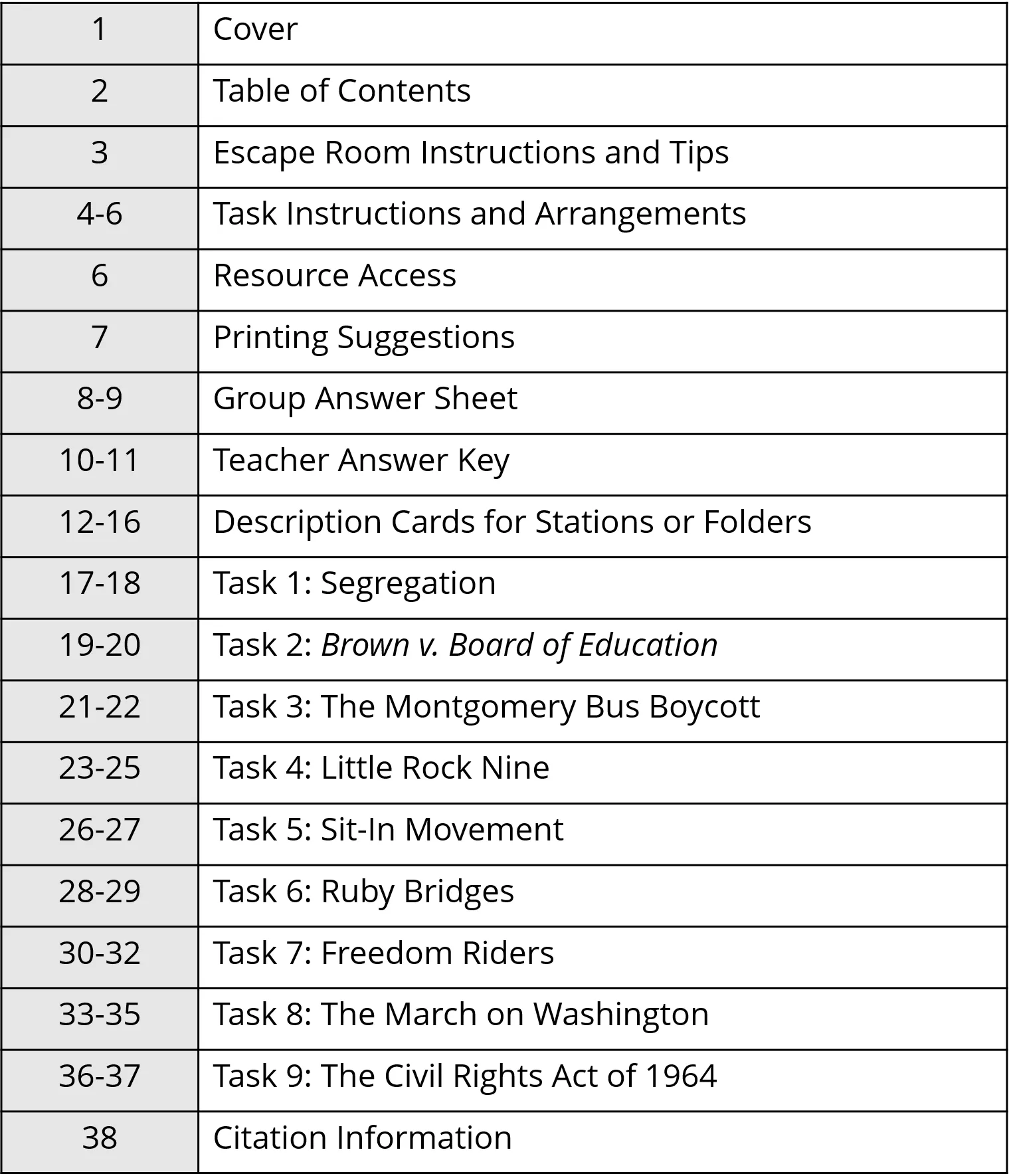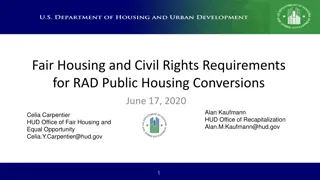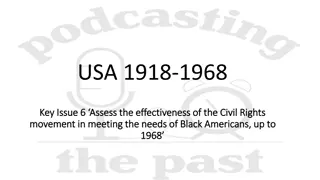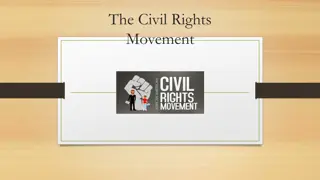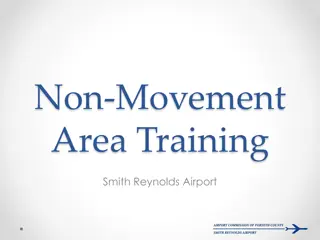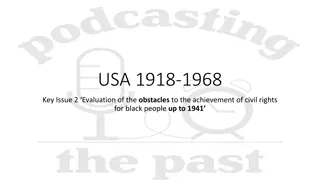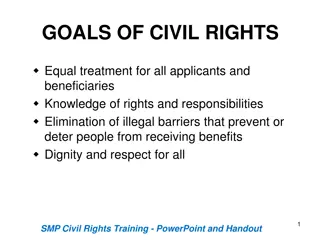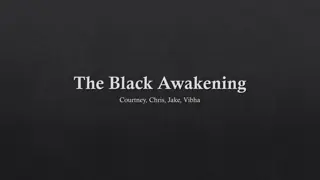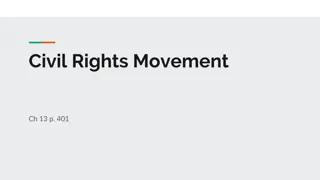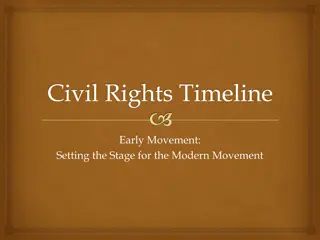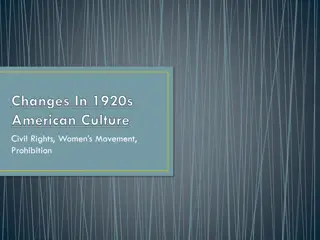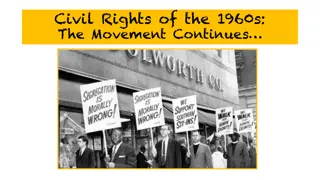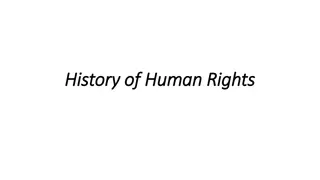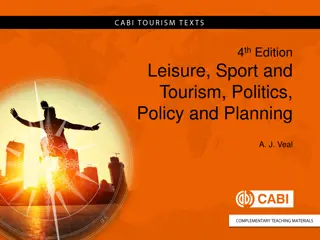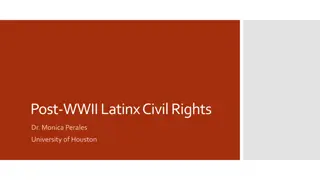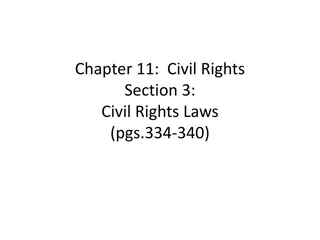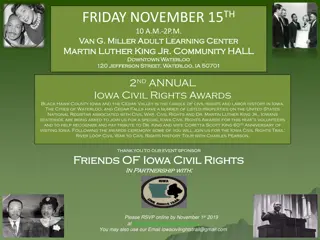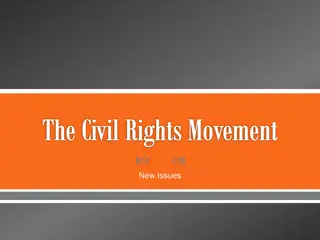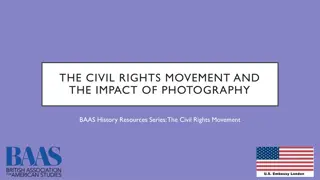High School Civil Rights Movement Escape Room
Engage high school students in an interactive escape room activity focused on key events and figures of the Civil Rights Movement. From segregation to landmark court cases and iconic protests, students will delve into the history through reading materials, questions, ciphers, and sorting tasks. This engaging and immersive experience can serve as an introduction or a culminating activity for a Civil Rights Movement unit, encouraging reflection and deeper research exploration.
Download Presentation

Please find below an Image/Link to download the presentation.
The content on the website is provided AS IS for your information and personal use only. It may not be sold, licensed, or shared on other websites without obtaining consent from the author.If you encounter any issues during the download, it is possible that the publisher has removed the file from their server.
You are allowed to download the files provided on this website for personal or commercial use, subject to the condition that they are used lawfully. All files are the property of their respective owners.
The content on the website is provided AS IS for your information and personal use only. It may not be sold, licensed, or shared on other websites without obtaining consent from the author.
E N D
Presentation Transcript
GALE IN CONTEXT: HIGH SCHOOL Civil Rights Movement Escape Room
TABLE OF CONTENTS 1 Cover 2 Table of Contents 3 Escape Room Instructions and Tips 4-6 Task Instructions and Arrangements 6 Resource Access 7 Printing Suggestions 8-9 Group Answer Sheet 10-11 Teacher Answer Key 12-16 Description Cards for Stations or Folders 17-18 Task 1: Segregation 19-20 Task 2: Brown v. Board of Education 21-22 Task 3: The Montgomery Bus Boycott 23-25 Task 4: Little Rock Nine 26-27 Task 5: Sit-In Movement 28-29 Task 6: Ruby Bridges 30-32 Task 7: Freedom Riders 33-35 Task 8: The March on Washington 36-37 Task 9: The Civil Rights Act of 1964 38 Citation Information
INSTRUCTIONS Print and organize all necessary materials (see Printing Suggestions). Some stations consist of cut-and-sort activities. You can choose to have students cut these as they progress and then sort or, you can have them cut and placed in envelopes or folders before they begin. Having them prepped beforehand is best practice. BEFORE Tasks can be set up as stations or as completion tasks where groups remain in one location. In either setup, it is important to have materials prepared that equal the number of groups. Having a folder/envelope for each task is best practice. Gale resources should be accessed through the Gale In Context: High School database. (See Resource Access page). Print Answer Key and have it on hand to answer questions and aid as needed. Walk around the room and assist groups when necessary. Each time a group finishes a task, check their code to approve them to go onto the next one. DURING Review reading material with students. This activity works well as an introduction to The Civil Rights Movement, or as a culminating activity at the end of a unit. Students can reflect about what they learned during the activity with reflection writing or use what they learned as a starting point for a deeper research project. AFTER
TASK 1: Segregation Instructions: Students will read the assigned Gale resource and learn about segregation and Plessy v. Ferguson. Students will answer the questions that go with the article on their group answer key. All spaces will be used. Each answer will have a highlighted letter, which is what will form their code. Arrangements: There are 2 sets of questions per page to cut back on copies. See Resource Access to determine how you want to share reading materials with your students. TASK 2: Brown v. Board of Education Instructions: Students will read the assigned Gale resource and learn about Brown v. Board of Education. Students will use the Pigpen cipher tool to decode the answer for the fill-in-the-blank statements. They will record the clues on their group answer sheet. The correctly deciphered words will serve as their code. Arrangements: It is recommended that you print a cipher for each student so that all students in the group can work together to decode. See Resource Access to determine how you want to share reading materials with your students. TASK 3: Montgomery Bus Boycott Instructions: Students will read the assigned Gale resource and learn about The Montgomery Bus Boycott. After reading the document, students will pair the numbered answers to their correct questions. When in the correct order, their code will be revealed. Arrangements: The activity for this is a cut-and-sort activity. You can have students cut them and then sort or have them precut and stored in an envelope or bag. See Resource Access to determine how you want to share reading materials with your students. TASK 4: The Little Rock Nine Instructions: Students will read the assigned Gale resource and learn about Daisy Bates and The Little Rock Nine. They will then complete the crossword puzzle. Highlighted boxes will reveal the code. Students will record code on group answer sheet. Arrangements: Consider making extra copies of the puzzle so students can see the questions and work together. See Resource Access to determine how you want to share reading materials with your students.
TASK 5: Sit-in Movement Instructions: Students will read the assigned Gale resource and learn about the Sit-In Movement. They will then review a series of statements from the article. They will circle the letters next to the statements that are TRUE. Those letters will reveal their code. Students will record code on group answer sheet. Arrangements: Consider making extra copies of the statements so students can see the questions and work together. See Resource Access to determine how you want to share reading materials with your students. TASK 6: Ruby Bridges Instructions: Students will read the assigned Gale resource and learn about Ruby Bridges. Students will then answer the multiple-choice questions. When answered correctly and in the correct order, their code will be revealed. Students will record code on group answer sheet. Arrangements: The activity for this is a cut-and-sort activity. You can have students cut them and then sort or have them precut and stored in an envelope or bag. See Resource Access to determine how you want to share reading materials with your students. TASK 7: Freedom Riders Instructions: Students will read the assigned Gale resource and learn about The Freedom Riders. Students will then complete the Tarsia puzzle by connecting the sides of each triangle to their corresponding question. They will end with a hexagon shape. Their code is a famous MLK Jr. quote, which will be visible once you complete the puzzle. They will record the code on their group answer sheet. Arrangements: The activity for this is a cut-and-sort activity. You can have students cut them and then sort or have them precut and stored in an envelope or bag. See Resource Access to determine how you want to share reading materials with your students. TASK 8: March on Washington Instructions: Students will read the assigned Gale resource and learn about The March on Washington. Students will match the parts of Martin Luther King Jr. s speech to its appropriate source or figurative language. The correct answers will reveal their code. Students will record code on group answer sheet. Arrangements: The activity for this is a cut-and-sort activity. You can have students cut them and then sort or have them precut and stored in an envelope or bag. See Resource Access to determine how you want to share reading materials with your students.
TASK 9: The Civil Rights Act of 1964 Instructions: Students will read the assigned Gale resource and learn about The Civil Rights Act of 1964. They will then put the events in the correct chronological order. Once in the correct order, their numerical code will be revealed. Students will record code on group answer sheet. Arrangements: The activity for this is a cut-and-sort activity. You can have students cut them and then sort or have them precut and stored in an envelope or bag. See Resource Access to determine how you want to share reading materials with your students. RESOURCE ACCESS The best way to have students access task articles it to have them visit Gale In Context and perform an Advanced Search. Provide students with the Gale Document Number. They will then select Gale Document Number from the Field drop-down menu and enter the document numbers below to access the content for each task. Task 1: Segregation JXMFAC651719898 Task 2: Brown v. Board of Education CX3444700199 Task 3: Montgomery Bus Boycott EJ2181500097 Task 4: Little Rock 9 EJ2108100190 Task 5: Sit-In Movement EJ2104240421 Task 6: Ruby Bridges CSSIWI600008872 Task 7: Freedom Rides CX3444700493 Task 8: March on Washington HOKJIC783806975 Task 9: The Civil Rights Act of 1964 LNKGTA841572691 Articles can also be shared with students via the Get Link tool.
PRINTING SUGGESTIONS Pages 8-9 Pages 10-11 Pages 12-16 Page 17 Page 18 Page 19 Page 20 Page 21 Page 22 Page 23 Page 24 Page 25 Page 26 Page 27 Page 28 Page 29 Page 30 Page 31-32 Page 33 Page 34-35 Page 36 Page 37 One answer sheet per group Answer Key TEACHER USE Description Cards for Stations or Folders (optional) Task 1 direction cards (2 per page) Task 1 questions (2 sets per page) Task 2 directions and cipher Task 2 cipher questions and activity Task 3 direction cards (2 per page) Task 3 questions (cut-and-sort) Task 4 direction cards (2 per page) Task 4 crossword puzzle Task 4 crossword puzzle clues Task 5 direction cards (2 per page) Task 5 true/false statements Task 6 direction cards (2 per page) Task 6 questions (cut-and-sort) Task 7 direction cards (2 per page) Task 7 Tarsia puzzle (cut-and-sort) Task 8 direction cards (2 per page) Task 8 questions (cut-and-sort) Task 9 direction cards (2 per page) Task 0 questions (cut-and-sort)
GROUP ANSWER SHEET Gale In Context: High School The Civil Rights Movement Escape Room Group Members: TASK 1 1. 2. 3. 4. 5. 6. 7. CODE CODE TASK 2 TASK 3 1. ____________________ 2. ____________________ 3. ____________________ 4. ____________________ 5. ____________________ 6. ____________________ ____ ____ ____ ____ ____ ____ ____ ____ ____ ____ ____ 1 2 3 4 5 6 7 8 9 10 11 TASK 5 T A S K 4 1. 7. 13. 2. 8. 14. 3. 9. 15. 4. 10. 16. 5. 11. Continue on the next page 6. 12.
TASK 6 ________ ________ ________ ________ ________ ________ _______ 1 2 3 4 5 6 7 ________________________________________________ _________________________________________________ ________________________________________________ TASK 7 - Martin Luther King Jr. TASK 8 TASK 9 1. _______________ ____ ____ ____ ____ ____ 2. _______________ ____ ____ ____ ____ 3. _______________ NOTES 4. _______________ 5. _______________ 6. _______________ 7. _______________ 8. _______________ YOU ESCAPED!
Gale In Context: High School The Civil Rights Movement Escape Room ANSWER KEY Group Members: TASK 1 1. E M A N C I P A T I O N 2. T H I R T E E N T H 3. J I M C R O W L A W S 4. F L O R I D A 5. L O U I S I A N A 6. S E P A R A T E B U T E Q U A L 7. C O N T R O V E R S I A L CODE CODE P R J O A B S TASK 2 TASK 3 1. Delaware 2. segregated 3. Thurgood 4. Fourteenth 5. inherently 6. deliberate _H_ _F_ _B_ _A_ _C_ _D_ _E_ _J_ _K_ _I_ _G_ 1 2 3 4 5 6 7 8 9 10 11 TASK 5 T A S K 4 1. S 7. A 13. U W B M N Z H C L 2. A 8. F 14. W 3. V 9. E 15. F 4. P 10. D 16.N 5. B 11. D FOR TEACHER USE 6. B 12. E
ANSWER KEY TASK 6 ___F___ ___R___ ___E___ ___E___ ___D___ ___O___ ___M___ 1 2 3 4 5 6 7 Injustice anywhere is a threat to justice everywhere. TASK 7 - Martin Luther King Jr. TASK 8 TASK 9 1. ____D____ __9__ __2__ __5__ __1__ __8__ 2. ____G____ __3__ __6__ __4__ __7__ 3. ____H____ NOTES 4. ____F____ 5. ____E____ 6. ____B____ 7. ____C____ 8. ____A____ YOU ESCAPED!
AP/Wide World Photos AP/Wide World Photos TASK 1 TASK 1 group answer sheet. record answers on our the code! Be sure to your task and crack resources to complete Use the Task 1 Segregation record answers on our resources to complete group answer sheet. the code! Be sure to your task and crack Segregation Use the Task 1 Bettmann/Getty Images Bettmann/Getty Images TASK 2 TASK 2 record answers on our group answer sheet. record answers on our the code! Be sure to your task and crack resources to complete Use the Task 2 of Education Brown v. Board resources to complete Brown v. Board group answer sheet. the code! Be sure to your task and crack of Education Use the Task 2
AP Images AP Images TASK 3 TASK 3 Montgomery Bus record answers on our Boycotts Montgomery Bus resources to complete group answer sheet. record answers on our the code! Be sure to your task and crack resources to complete Use the Task 3 group answer sheet. the code! Be sure to your task and crack Use the Task 3 Boycotts Bettmann/CORBIS Bettmann/CORBIS TASK 4 TASK 4 Little Rock Nine Little Rock Nine group answer sheet. record answers on our the code! Be sure to your task and crack resources to complete Use the Task 4 record answers on our resources to complete group answer sheet. the code! Be sure to your task and crack Use the Task 4
TASK 5 TASK 5 Sit-In Movement group answer sheet. record answers on our the code! Be sure to your task and crack resources to complete Use the Task 5 Sit-In Movement record answers on our resources to complete group answer sheet. the code! Be sure to your task and crack Use the Task 5 DONAL UHRBROCK/THE LIFE PICTURE COLLECTION/ GETTY IMAGES DONAL UHRBROCK/THE LIFE PICTURE COLLECTION/ GETTY IMAGES TASK 6 TASK 6 record answers on our group answer sheet. record answers on our the code! Be sure to your task and crack resources to complete Use the Task 6 Ruby Bridges resources to complete group answer sheet. the code! Be sure to your task and crack Ruby Bridges Use the Task 6
EVERETT COLLECTION INC/ALAMY EVERETT COLLECTION INC/ALAMY TASK 7 TASK 7 Freedom Riders record answers on our group answer sheet. record answers on our the code! Be sure to your task and crack resources to complete Use the Task 7 Freedom Riders resources to complete group answer sheet. the code! Be sure to your task and crack Use the Task 7 Wally McNamee/CORBIS/Getty Images/TNS Wally McNamee/CORBIS/Getty Images/TNS TASK 8 TASK 8 record answers on our resources to complete group answer sheet. record answers on our the code! Be sure to your task and crack resources to complete Use the Task 8 Washington March on group answer sheet. the code! Be sure to your task and crack Washington Use the Task 8 March on
UPI/Corbis-Bettmann. UPI/Corbis-Bettmann. TASK 9 TASK 9 The Civil Rights record answers on our group answer sheet. record answers on our the code! Be sure to your task and crack resources to complete Use the Task 9 Act of 1964 The Civil Rights resources to complete group answer sheet. the code! Be sure to your task and crack Act of 1964 Use the Task 9
SEGREGATION TASK 1 Following the end of the American Civil War (1861 1865) and the abolition of slavery, African Americans entered the country s social mainstream with new rights including citizenship and the right to vote. However, their rights were quickly undermined by a series of Supreme Court rulings establishing the legal segregation of white people and black people. Racism was still a prevalent feature of everyday life in the United States, and in many places, particularly in the Southern states, black people were widely viewed as second-class citizens. Segregation was achieved through a series of statutes informally known as the Jim Crow laws that instituted the physical separation of white people and black people in public spaces, which included transportation, schools, accommodations, and recreational areas. Directions: Read the assigned case overview on Plessy v. Ferguson inGale In Context: High School. Use what you learn to answer the questions on your group answer key. Shaded boxes will reveal your code. Get approval of correct code before moving on to task 2. - - - - - - - - - - - - - - - - - - - - - - - - - - - - - - - - - - - - - - - - - - - - - - - - - - - - - - - SEGREGATION TASK 1 Following the end of the American Civil War (1861 1865) and the abolition of slavery, African Americans entered the country s social mainstream with new rights including citizenship and the right to vote. However, their rights were quickly undermined by a series of Supreme Court rulings establishing the legal segregation of white people and black people. Racism was still a prevalent feature of everyday life in the United States, and in many places, particularly in the Southern states, black people were widely viewed as second-class citizens. Segregation was achieved through a series of statutes informally known as the Jim Crow laws that instituted the physical separation of white people and black people in public spaces, which included transportation, schools, accommodations, and recreational areas. Directions: Read the assigned case overview on Plessy v. Ferguson inGale In Context: High School. Use what you learn to answer the questions on your group answer key. Shaded boxes will reveal your code. Get approval of correct code before moving on to task 2.
1. In 1863, President Abraham Lincoln enacted the ___________________ Proclamation. 2. Which amendment formally abolished slavery? 3. With the newly Democrat-controlled legislatures, Southern politicians began to enact a series of controversial measures called what? 4. What was the first state to enact segregationist laws? 5. In Plessy v. Ferguson the Supreme Court ruled 7 1 in favor of who? 6. Plessy v Ferguson established what doctrine? 7. Plessy v. Ferguson is widely regarded as one of the most ______________________ and unpopular decisions in the history of the Supreme Court. - - - - - - - - - - - - - - - - - - - - - - - - - - - - - - - - - - - - - - - - - - - - - - - - - - - - - - - 1. In 1863, President Abraham Lincoln enacted the ___________________ Proclamation. 2. Which amendment formally abolished slavery? 3. With the newly Democrat-controlled legislatures, Southern politicians began to enact a series of controversial measures called what? 4. What was the first state to enact segregationist laws? 5. In Plessy v. Ferguson the Supreme Court ruled 7 1 in favor of who? 6. Plessy v Ferguson established what doctrine? 7. Plessy v. Ferguson is widely regarded as one of the most ______________________ and unpopular decisions in the history of the Supreme Court.
TASK 2 BROWN V. BOARD OF EDUCATION Brown v. Board of Education was a landmark US Supreme Court decision made in 1954 that found that state and local governments could not force black and white children to attend separate schools a practice called segregation that had been implemented throughout the country but was most prominent in the South. This case was extremely important because it overturned another Supreme Court case, Plessy v. Ferguson (1896), which had stated that separate but equal facilities were acceptable for black and white people. Directions: Read the assigned topic overview on Brown v. Board of Education in Gale In Context: High School. Use the Pigpen cipher tool to decode the clues. Answer the questions on your group answer key. Get approval of correct code before moving on to task 3. - - - - - - - - - - - - - - - - - - - - - - - - - - - - - - - - - - - - - - - - - - - - - - - - - - - - - - - TASK 2 BROWN V. BOARD OF EDUCATION Brown v. Board of Education was a landmark US Supreme Court decision made in 1954 that found that state and local governments could not force black and white children to attend separate schools a practice called segregation that had been implemented throughout the country but was most prominent in the South. This case was extremely important because it overturned another Supreme Court case, Plessy v. Ferguson (1896), which had stated that separate but equal facilities were acceptable for black and white people. Directions: Read the assigned topic overview on Brown v. Board of Education in Gale In Context: High School. Use the Pigpen cipher tool to decode the clues. Answer the questions on your group answer key. Get approval of correct code before moving on to task 3.
1. Brown combined separate cases from Kansas, South Carolina, Virginia, and _____________. 2. In 1954 laws in eighteen states plus the District of Columbia mandated __________________ schools. 3. In Brown the NAACP Legal Defense Fund, led by ______________ Marshall, decided to directly challenge the whole idea of segregation in schools. 4. The Court was also compelled to consider the meaning of the ________________ Amendment. 5. Warren found that "in the field of public education the doctrine of 'separate but equal' has no place. Separate education facilities are _________________ unequal." 6. The NAACP urged immediate desegregation. However, in a second case, known as Brown II (1955), the Court ordered its mandate implemented with "all _______________ speed," a process that turned out to be extraordinarily slow.
The Montgomery Bus TASK 3 Boycott In early December 1955, members of the Black community in Montgomery, Alabama, began a 381-day-long boycott of the city s segregated bus system. The incident that sparked the boycott was the arrest, on December 1, of Rosa Parks who, while riding a city bus home from work that evening, refused to give up her seat to a white passenger. The boycott ended on December 21, 1956, after the US Supreme Court upheld a lower court ruling that Alabama s bus segregation laws were unconstitutional.. Directions: Read the assigned resource on The Montgomery Bus Boycotts in Gale In Context: High School. After reading, pair the answer with its correct response. Once in order, your code will be revealed. Get approval of correct code before moving on to task 4 - - - - - - - - - - - - - - - - - - - - - - - - - - - - - - - - - - - - - - - - - - - - - - - - - - - - - - - - - - - - - - - - - - - - - - - - - - - - - - - - - - - - - - - - - - - - - - - - - - - - - - - - - - - - - - The Montgomery Bus TASK 3 Boycott In early December 1955, members of the Black community in Montgomery, Alabama, began a 381-day-long boycott of the city s segregated bus system. The incident that sparked the boycott was the arrest, on December 1, of Rosa Parks who, while riding a city bus home from work that evening, refused to give up her seat to a white passenger. The boycott ended on December 21, 1956, after the US Supreme Court upheld a lower court ruling that Alabama s bus segregation laws were unconstitutional.. Directions: Read the assigned resource on The Montgomery Bus Boycotts in Gale In Context: High School. After reading, pair the answer with its correct response. Once in order, your code will be revealed. Get approval of correct code before moving on to task 4
1 A Viewed as the beginning of the modern struggle for civil rights in America. Forward B 2 Races sitting across from or next to each other. The section Rosa Parks was seated in when she was arrested. C The time Martin Luther King Jr. spent in jail for his role in the bus boycotts. 3 The Black Section 4 D The Montgomery Bus Boycott Black passengers stepped onto the bus to pay their fare and then 5 E The number of leaflets that were distributed about boycotting the bus system on December 5th. 2 weeks 6 they had to exit the bus and reenter through the doors in the rear. F Segregation laws also prohibited G The number of black people arrested for violating a 1921 state law prohibiting boycotts without a just or legal cause. 7 52,000 Martin Luther King Jr. 8 H These rows of city buses were reserved for white passengers only. 9 Taxis I He was brought in to help organize a massive carpool operation. 10 T. J. Jemison J He was among the first to notice the empty buses. 11 115 In the first week, many of those boycotting the bus system used these to get around. K
LITTLE ROCK NINE TASK 4 On September 4, 1957, nine African American students attempted to enter Little Rock (Arkansas) Central High school. The nine students, escorted by National Association for the Advancement of Colored People (NAACP) representative Daisy Bates, were turned away by National Guard troops stationed at the high school by the state s governor, Orval Faubus. On September 23, the nine entered the school for the first time, escorted by local police, but were later removed after segregationists threatened to riot outside the school building. On September 25, accompanied by troops from the 101st Airborne Division, the nine were escorted back into Central for their first full day of classes. Directions: Read the assigned resource on journalist Daisy Bates in Gale In Context: High School. Using the information from the reading, complete the crossword puzzle. Highlighted boxes will reveal code. Record code on group answer sheet and get approval before moving on to task 5. - - - - - - - - - - - - - - - - - - - - - - - - - - - - - - - - - - - - - - - - - - - - - - - - - - - - - - - LITTLE ROCK NINE TASK 4 On September 4, 1957, nine African American students attempted to enter Little Rock (Arkansas) Central High school. The nine students, escorted by National Association for the Advancement of Colored People (NAACP) representative Daisy Bates, were turned away by National Guard troops stationed at the high school by the state s governor, Orval Faubus. On September 23, the nine entered the school for the first time, escorted by local police, but were later removed after segregationists threatened to riot outside the school building. On September 25, accompanied by troops from the 101st Airborne Division, the nine were escorted back into Central for their first full day of classes. Directions: Read the assigned resource on journalist Daisy Bates in Gale In Context: High School. Using the information from the reading, complete the crossword puzzle. Highlighted boxes will reveal code. Record code on group answer sheet and get approval before moving on to task 5.
CROSSWORD TASK 4
CROSSWORD CLUES TASK 4 Down: 1. The attack on Eckford set off a round of mob violence in the city that lasted ____________________days. Across: 4. Wilson ordered a thousand _______________________to the area, and President Eisenhower went on television to announce that the troops would enforce federal law in Little Rock. 2. Bates and her husband used their savings to lease the ____________________State Press. 6. On October 31, the Little Rock City Council ordered the chief of police to arrest _____________, and she was eventually fined one hundred dollars. 3. On September 2, 1957, the Arkansas National Guard were summoned to Central High School to prevent an outbreak of ______________. 9. Daisy Bates took the children to the white public school with photographers from the State Press and other newspapers present to see if they could _____________ in the school. 5. The paper that strived for better social and economic conditions for blacks throughout the state, and it exposed police ____________________in Little Rock. 10. Daisy attended a segregated public school in Huttig, where the students used textbooks that were ______________from the white school. 7. Daisy Bates was raised by __________ parents. 8. President Dwight D. Eisenhower _______________________all units of the Arkansas National Guard and ordered Secretary of Defense Charles Wilson to enforce the integration laws. 12. Elizabeth _____________________ displayed dignity under pressure and became a source of inspiration to other black people. 13. "She was a good infighter, persistent, intelligent, _______________________ a woman who made a choice of this career fully aware of its dangers to her person and also its rewards in the prestige and service of her people," Elizabeth Huckaby, vice-principal of Central, once said of Bates. 11. The rock had a note attached: "Stone this time, ______________ next. 14.On August 22, 1957, a rock was thrown through the front _______________of Bates's home. 15. On August 29, 1957, Judge Murray O. Reed issued an __________________ halting the integration of Central High School based on a rumor that white and black children were forming gangs, with some of them carrying knives and guns. 16. Only __________ students agreed to attend an integrated school.
SIT-IN MOVEMENT TASK 5 In February 1960 a group of black college students in Greensboro, North Carolina, refused to leave a whites-only lunch counter at which they were denied service. Their demonstration began the sit-in movement, a series of peaceful protests that brought renewed national attention to the injustices of the segregated South and eventually forced the federal government to protect the rights of African Americans actively. Directions: Read the assigned article on The Sit-In Movement in Gale In Context: High School. Circle the letters of the statements that are TRUE. This will reveal your code. Record code on group answer sheet and get approval before moving on to task 6. - - - - - - - - - - - - - - - - - - - - - - - - - - - - - - - - - - - - - - - - - - - - - - - - - - - - - - - SIT-IN MOVEMENT TASK 5 In February 1960 a group of black college students in Greensboro, North Carolina, refused to leave a whites-only lunch counter at which they were denied service. Their demonstration began the sit-in movement, a series of peaceful protests that brought renewed national attention to the injustices of the segregated South and eventually forced the federal government to protect the rights of African Americans actively. Directions: Read the assigned article on The Sit-In Movement in Gale In Context: High School. Circle the letters of the statements that are TRUE. This will reveal your code. Record code on group answer sheet and get approval before moving on to task 6.
SIT-IN MOVEMENT TASK 5 Circle the letters of the statements that are TRUE. This will reveal your code. In February 1960 a group of black college students in Greensboro, North Carolina, refused to leave a whites-only lunch counter at which they were denied service. W R Over several weeks the strategy spread to hundreds of southern cities and towns. X The students occupied half the seats at the counter and left only when it closed B In Nashville, Tennessee, the protesters were physically attacked. P When the Nashville police arrived In Nashville the attackers were arrested. As the peaceful protesters presented their case in court, the judge turned his back to their lawyer. M N Protestors would often attend workshops to learn nonviolent resistance techniques. In mid April 1960 black students from throughout the South and northern white supporters came together on the campus of NC State University in Raleigh, North Carolina. The home of Z. Alexander Looby, the first African American to serve on Nashville's city council and the lawyer who had represented the sit-in protesters in court, was destroyed by dynamite thrown from a passing car. Q Z G A few hours later thirty-five hundred students and townspeople marched on city hall. Several weeks later, the sit-in movement achieved its first major victory when six Nashville lunch counters began to serve black patrons. H By the end of the summer, twenty-seven Southern cities had agreed to integrate the restaurants in their community. C They organized "stand-ins" at segregated movie theaters and "sleep-ins" at segregated hotels as well as protests at the department stores which continued to segregate their lunch counters and dressing rooms. L In October 1960 the Reverend Martin Luther King, Jr., was arrested in Atlanta, Georgia, for participating in a sit-in at a Woolworth s department store. J
RUBY BRIDGES TASK 6 At the age of six, Ruby Bridges became an icon of the Civil Rights Movement in November 1960 when she became the first African American student to attend an all-white school in New Orleans. Because of the overt racism she faced from angry protestors outside the school, Bridges and her mother were escorted into the school by four federal marshals. The experience inspired Bridges to become a lifelong activist for racial equality, establishing the Ruby Bridges Foundation in 1999 to promote tolerance and respect. Directions: Read the assigned document on Ruby Bridges in Gale in Context: High School. Using the information learned from the document, answer the multiple- choice questions for task 6. Your answers will reveal your code. Record code on group answer sheet and get approval before moving on to task 7. - - - - - - - - - - - - - - - - - - - - - - - - - - - - - - - - - - - - - - - - - - - - - - - - - - - - - - - RUBY BRIDGES TASK 6 At the age of six, Ruby Bridges became an icon of the Civil Rights Movement in November 1960 when she became the first African American student to attend an all-white school in New Orleans. Because of the overt racism she faced from angry protestors outside the school, Bridges and her mother were escorted into the school by four federal marshals. The experience inspired Bridges to become a lifelong activist for racial equality, establishing the Ruby Bridges Foundation in 1999 to promote tolerance and respect. Directions: Read the assigned document on Ruby Bridges in Gale in Context: High School. Using the information learned from the document, answer the multiple- choice questions for task 6. Your answers will reveal your code. Record code on group answer sheet and get approval before moving on to task 7.
1.In what year did a federal judge order the desegregation of Louisiana Schools? d.1954 f. 1959 e. 1962 g. 1957 2. School districts in Louisiana required African American students to take and pass an entrance examination. Ruby and how many others passed the exam? q. Seven s. Eight r. Five t. Nine 3. The school district, knowing Bridges would be the only African American student, pushed her start date back to _____________ to avoid scandal. b. October 1 d. August 30 c. September 12 e. November 14 4. What was the name of the young white woman from Boston who volunteered to teach Bridges? d. Elizabeth McKay f. Barbara Kennedy e. Barbara Henry g. Daisy Bates 5. Backlash from Bridges desegregation affected her family. For example, Her grandparents were evicted from the farm that they had sharecropped and lived on for how long? d. 25 years f. 20 years e. 15 years g. 18 years 6. Norman Rockwell s painting of Ruby s first day was called what? l. This is America n. The Anger Over One m. A Problem with a Child o. The Problem We All Must Live With 7. Who published the book The Story of Ruby Bridges ? l. Barbara Henry n. Ruby Bridges m. Robert Coles o. Rosa Parks
FREEDOM RIDERS TASK 7 The Freedom Riders were a group of antiracism activists who challenged segregation laws on interstate public transportation in the early 1960s. Suffering harassment and enduring abuse including beatings and imprisonment, the Freedom Riders nonetheless played a major role in the abolishment of segregation laws throughout the American South. The Freedom Riders movement began with thirteen members in 1961, and ultimately grew to include more than 450 activists who combined to take part in dozens of bus trips. Directions: Read the assigned document on the Freedom Riders in Gale In Context: High School. Then complete the Tarsia puzzle by connecting the sides of each triangle to their corresponding question. You will end with a hexagon shape. Your code is a famous MLK Jr. quote, which will be visible once you complete the puzzle. Record code on group answer sheet and get approval before moving on to task 8. - - - - - - - - - - - - - - - - - - - - - - - - - - - - - - - - - - - - - - - - - - - - - - - - - - - - - - - FREEDOM RIDERS TASK 7 The Freedom Riders were a group of antiracism activists who challenged segregation laws on interstate public transportation in the early 1960s. Suffering harassment and enduring abuse including beatings and imprisonment, the Freedom Riders nonetheless played a major role in the abolishment of segregation laws throughout the American South. The Freedom Riders movement began with thirteen members in 1961, and ultimately grew to include more than 450 activists who combined to take part in dozens of bus trips. Directions: Read the assigned document on the Freedom Riders in Gale In Context: High School. Then complete the Tarsia puzzle by connecting the sides of each triangle to their corresponding question. You will end with a hexagon shape. Your code is a famous MLK Jr. quote, which will be visible once you complete the puzzle. Record code on group answer sheet and get approval before moving on to task 8.
The federal case that resulted in the legal ban of segregation on interstate buses and trains. The first group consisted of seven black people and how many white people? The plan was to end with a desegregation rally where? is anywhere
justice to New Orleans, Louisiana six Morgan v. Virginia
TASK 8 MARCH ON WASHINGTON The March on Washington for Jobs and Freedom, popularly known as the 1963 March on Washington, was a massive civil rights demonstration staged in Washington, DC. Attended by an estimated 250,000 people, the 1963 March on Washington was, at the time, the largest civil rights-related protest in the history of the United States. It is widely celebrated as a seminal moment in twentieth-century US history, as it succeeded in pressuring the presidential administration of John F. Kennedy into enshrining major civil rights reforms in the Civil Rights Act (1964). The 1963 March on Washington was also the backdrop for the famous I Have a Dream speech by the revered racial justice hero Dr. Martin Luther King, Jr. Directions: Read the assigned resource on the I Have A Dream speech in Gale in Context: High School. Match the parts of Martin Luther King Jr. s speech to its appropriate source or figurative language. The correct answers will reveal your code. Record code on group answer sheet and get approval before moving on to task 8. - - - - - - - - - - - - - - - - - - - - - - - - - - - - - - - - - - - - - - - - - - - - - - - - - - - - - - - TASK 8 MARCH ON WASHINGTON The March on Washington for Jobs and Freedom, popularly known as the 1963 March on Washington, was a massive civil rights demonstration staged in Washington, DC. Attended by an estimated 250,000 people, the 1963 March on Washington was, at the time, the largest civil rights-related protest in the history of the United States. It is widely celebrated as a seminal moment in twentieth-century US history, as it succeeded in pressuring the presidential administration of John F. Kennedy into enshrining major civil rights reforms in the Civil Rights Act (1964). The 1963 March on Washington was also the backdrop for the famous I Have a Dream speech by the revered racial justice hero Dr. Martin Luther King, Jr. Directions: Read the assigned resource on the I Have A Dream speech in Gale in Context: High School. Match the parts of Martin Luther King Jr. s speech to its appropriate source or figurative language. The correct answers will reveal your code. Record code on group answer sheet and get approval before moving on to task 8.
2 He cited its significance in providing hope to the freed Light and Darkness 1 slaves 3 Five score years ago.. 4 It is obvious today that America has defaulted on this promissory note insofar as her citizens of color are concerned. Instead of honoring this sacred obligation, America has given the Negro people a bad check: a check which has come back marked "insufficient funds." But we refuse to believe that the bank of 5 Oh, free at last, free at last I thank God I m free at last Free at last, free at last I thank God I m free at last. justice is bankrupt. We hold these truths to be self- evident, that all men are created equal. That they are endowed by their Creator with certain unalienable Rights, that among these are Life, Liberty and the pursuit of Happiness. 7 My country tis of thee, Sweet land of liberty, Of thee I sing. Land where my fathers died! Land of the Pilgrim s pride! From every mountain side, Let freedom ring! 6 "I have a dream that my four little children will one day live in a nation where they will not be judged by the color of their skin but by the content of their character." "We are not satisfied, and we will not be satisfied until "justice rolls down like waters and righteousness like a mighty stream." 8 9 "I have a dream that one day this nation will rise up and live out the true meaning of its creed." 10
H D The Gettysburg Address Good and Evil G C The The US Emancipation Proclamation Constitution B F America! By Samuel Francis Smith Metaphor A E Simile Repetition I J Alliteration Personification
THE CIVIL RIGHTS ACT OF TASK 9 1964 The Civil Rights Act of 1964 was a landmark piece of legislation passed by Congress to ban discrimination on the basis of race, color, religion, sex or national origin. The Act outlawed the practice of public segregation and was a major victory in the Civil Rights movement of the 1950s and 1960s. The Act also inspired several other important pieces of legislation that expanded the rights of minorities in the United States. Directions: Read the assigned resource on The Civil Rights Act of 1964 in Gale In Context: High School. Arrange the events in the order in which they occur. When in the correct chronological order, you code will be revealed and you finally escape! - - - - - - - - - - - - - - - - - - - - - - - - - - - - - - - - - - - - - - - - - - - - - - - - - - - - - - - THE CIVIL RIGHTS ACT OF TASK 9 1964 The Civil Rights Act of 1964 was a landmark piece of legislation passed by Congress to ban discrimination on the basis of race, color, religion, sex or national origin. The Act outlawed the practice of public segregation and was a major victory in the Civil Rights movement of the 1950s and 1960s. The Act also inspired several other important pieces of legislation that expanded the rights of minorities in the United States. Directions: Read the assigned resource on The Civil Rights Act of 1964 in Gale In Context: High School. Arrange the events in the order in which they occur. When in the correct chronological order, you code will be revealed and you finally escape!
Protests, boycotts, and marches were organized across the 1 country. 2 The Emancipation Proclamation 3 President John F. Kennedy was assassinated. 4 The Voting Rights Act of 1965 was passed. Jim Crow Laws in the South strictly reduced the rights of Black Americans and attempted to re-establish conditions similar to those that existed under slavery. 5 In summer of 1964, Congress passed Public Law 88 352 (78 Stat. 241), also known as the Civil Rights Act of 1964. 6 Congress passed the Fair Housing Act of 1968, which made it illegal to discriminate on the basis of race when selling, financing, leasing, or renting property. 7 President John F. Kennedy noted the significant resistance to the national integration movement, and asked Congress to develop a new civil-rights bill. 8 9 The Civil War
CITATION INFORMATION TASK 1 "Plessy v. Ferguson." Gale In Context Online Collection, Gale, 2022. Gale In Context: HighSchool,link.gale.com/apps/doc/JXMFAC651719898/SUIC?u=[LOCATIONID] &sid=bookmark-SUIC&xid=3d5644b2. Accessed 30 Jan. 2023. Finkelman, Paul. "Brown v. Board of Education of Topeka, Kansas." Encyclopedia of African-American Culture and History, edited by Colin A. Palmer, 2nd ed., vol. 1, Macmillan Reference USA, 2006, pp. 349-350. Gale In Context: High School, link.gale.com/apps/doc/CX3444700199/SUIC?u=[LOCATIONID]&sid=bookmark- SUIC&xid=c7addd1b. Accessed 3 Feb. 2023. TASK 2 TASK 3 TASK 4 TASK 5 TASK 6 "Montgomery Bus Boycott, 1955." Gale In Context Online Collection, Gale, 2023. Gale InContext:HighSchool,link.gale.com/apps/doc/EJ2181500097/SUIC?u=[LOCATIO NID]&sid=bookmark-SUIC&xid=7e3e9a0e. Accessed 3 Feb. 2023. "Daisy Bates." UXL Biographies, UXL, 2011. Gale In Context: High School, link.gale.com/apps/doc/EJ2108100190/SUIC?u=[LOCATIONID]&sid=bookmark- SUIC&xid=dbdc5046. Accessed 3 Feb. 2023. "Sit-In Movement of the 1960s." DISCovering U.S. History, Gale, 2003. Gale In Context: HighSchool,link.gale.com/apps/doc/EJ2104240421/SUIC?u=[LOCATIONID]&sid= bookmark-SUIC&xid=7cd227f5. Accessed 3 Feb. 2023. "Ruby Bridges." Gale In Context Online Collection, Gale, 2022. Gale In Context: High School,link.gale.com/apps/doc/CSSIWI600008872/SUIC?u=[LOCATIONID]&sid= bookmark-SUIC&xid=b6f68680. Accessed 3 Feb. 2023. Graham, Jessica L. "Freedom Rides." Encyclopedia of African-American Culture and History, edited by Colin A. Palmer, 2nd ed., vol. 2, Macmillan Reference USA, 2006,pp.879-880.GaleInContext:HighSchool,link.gale.com/apps/doc /CX3444700493/SUIC?u=[LOCATIONID]&sid=bookmark-SUIC&xid=0b32fab6. Accessed 3 Feb. 2023. TASK 7 TASK 8 "I Have a Dream." Gale In Context Online Collection, Gale, 2019. Gale In Context: High School,link.gale.com/apps/doc/HOKJIC783806975/SUIC?u=[LOCATIONID]&sid= bookmark-SUIC&xid=55b3ea2a. Accessed 3 Feb. 2023. TASK 9 "Civil Rights Act of 1964." Gale In Context Online Collection, Gale, 2022. Gale In Context:HighSchool,link.gale.com/apps/doc/LNKGTA841572691/SUIC?u=[LOCA TIONID]&sid=bookmark-SUIC&xid=f9d5f603. Accessed 3 Feb. 2023. EXPLORE MORE! Find more classroom resources and support materials at: support.gale.com








